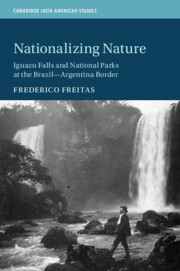Book contents
- Nationalizing Nature
- Cambridge Latin American Studies
- Nationalizing Nature
- Copyright page
- Dedication
- Contents
- Figures, Maps, and Tables
- Acknowledgments
- Note on Terminology and Orthography
- Introduction: Boundaries of Nature
- 1 Nationalizing the Border
- 2 Playing Catch-Up
- 3 A Park and a Town
- 4 Land Conflict
- 5 Surveillance and Evasion
- 6 The View from Above
- Epilogue: The Resilience of Boundaries
- Bibliography and Sources
- Index
- Other Books in the Series (continued from page ii)
3 - A Park and a Town
Argentina, 1945–1979
Published online by Cambridge University Press: 08 March 2021
- Nationalizing Nature
- Cambridge Latin American Studies
- Nationalizing Nature
- Copyright page
- Dedication
- Contents
- Figures, Maps, and Tables
- Acknowledgments
- Note on Terminology and Orthography
- Introduction: Boundaries of Nature
- 1 Nationalizing the Border
- 2 Playing Catch-Up
- 3 A Park and a Town
- 4 Land Conflict
- 5 Surveillance and Evasion
- 6 The View from Above
- Epilogue: The Resilience of Boundaries
- Bibliography and Sources
- Index
- Other Books in the Series (continued from page ii)
Summary
The third chapter provides an account of the Argentine Iguazú National Park’s first forty years. Initially conceived as an instrument to foster border colonization, the park included urban settlements inside its protected area, which set Argentine national parks apart internationally. Park directors attracted settlers from other regions of Argentina with promises of cheap lots and jobs in infrastructure projects and sought to transform them into a model border population. Throughout the years, life scientists at the Argentine national park agency criticized this policy of settlements inside national parks. At the same time, members of international bodies such as the International Union for Conservation of Nature (IUCN) proposed a redefinition of the idea of national park, one which excluded the presence of humans. This debate ultimately informed changes in conservation policy in Argentina in the 1960s and 1970s. Scientists and park officials began advocating abroad for a more restrictive definition to influence policymakers at home. By the 1970s, the conservationists in the agency prevailed, adopting the international discourse of strict nature conservation, retracing park boundaries, and evicting settlers.
Keywords
- Type
- Chapter
- Information
- Nationalizing NatureIguazu Falls and National Parks at the Brazil-Argentina Border, pp. 97 - 144Publisher: Cambridge University PressPrint publication year: 2021

